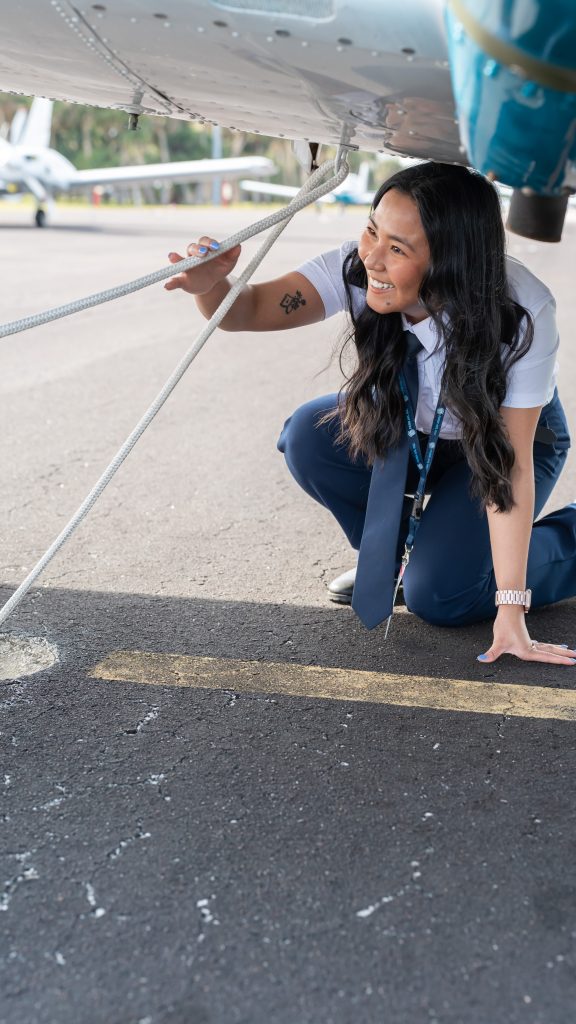How to Stay Sharp Between Flights:
Flight training is exciting, intense, and full of hands-on experience—but what about the days you’re not in the cockpit? Whether you’re waiting on weather, scheduling, or budget limitations, time away from the plane doesn’t have to mean losing progress. At-home drills for student pilots can bridge the gap between the air and ground training. In fact, some of the most valuable pilot skills can be sharpened right from the comfort of home.
At Paris Air, we encourage our student pilots to treat flight training like any other discipline: practice consistently, even when you’re not flying. Here are five at-home drills to keep your skills sharp and your mind flight-ready between lessons.

Chair Flying: The Classic Mental Rehearsal
“Chair flying” is a time-tested method where you simulate flying in your mind while sitting in a chair—often with a printed cockpit diagram or a makeshift yoke in hand.
How to Practice:
- Sit in a quiet space and visualize your aircraft’s cockpit.
- Talk through your checklist out loud: pre-flight, run-up, takeoff, climb, cruise, approach, and landing.
- Use your hands to simulate control movements.
- Include radio calls, switch flips, and checklist references.
What It Helps With:
- Builds muscle memory for procedures
- Reinforces checklist flow and cockpit resource management
- Reduces task saturation during real flights
At Paris Air, many find that chair flying one of the at-home drills for student pilots that is useful before a checkride or solo helps calm nerves and solidify procedural recall.
Review & Quiz Yourself on VFR/IFR Charts
Being comfortable reading aviation charts is a key skill for student pilots. If you’re learning VFR navigation or moving toward instrument training, regular review of sectional and approach charts can help you stay proficient.
How to Practice:
- Download current sectional charts for your training area (try Vero Beach and surrounding airspace).
- Identify landmarks, airspaces, and frequencies.
- Try to plan a mock cross-country route.
- Use online tools or apps like ForeFlight or SkyVector for simulation.
What It Helps With:
- Airspace awareness
- Navigational planning and situational awareness
- Prepares you for both written and practical tests
Bonus: Make it a game! Try timing yourself to find specific landmarks or decode METARs and TAFs.
Practice Radio Communications
Talking on the radio is one of the most intimidating parts of flight training for new students—but also one of the easiest to practice at home.
How to Practice:
- Record yourself giving mock radio calls (ground, tower, approach).
- Listen to live ATC via apps like LiveATC.net to get familiar with real-world cadence.
- Write out and rehearse common radio calls for your airfield.
What It Helps With:
- Builds confidence with phraseology
- Reduces hesitation during real-time transmissions
- Trains your ear to understand rapid or busy ATC chatter
Paris Air students often comment how this practice helps make their radio work feel more natural—especially when flying in and out of controlled airspace like Vero Beach (VRB).
Study Your Aircraft POH and Checklists
Understanding the Pilot’s Operating Handbook (POH) for your specific aircraft is a key part of becoming a confident, safe pilot. If you’re flying a Cessna 172 or Piper Archer, use downtime to become fluent in performance charts, systems, and limitations. Maybe not as traditional as the other at-home drills for student pilots, but studying and walking through the POH & checklists is a great tool.
How to Practice:
- Read a few pages of the POH daily—especially the systems and emergency procedures sections.
- Quiz yourself on speeds, weight and balance limits, and normal/abnormal procedures.
- Create flashcards for memory items or red-bordered emergency checklists.
What It Helps With:
- Deeper understanding of your aircraft systems
- Quicker emergency response and decision-making
- Reinforces key memory items required for checkrides
This habit helps students feel more in command and also saves valuable time during in-person ground school.
Use Flight Simulators to Reinforce Maneuvers
Flight simulation has come a long way. Tools like Microsoft Flight Simulator, X-Plane, or even mobile apps allow you to practice basic and advanced flight maneuvers from home.
How to Practice:
- Set up a basic sim with a joystick or yoke (or use a touchscreen app if you’re on a budget).
- Practice maneuvers you’ve learned in training: slow flight, steep turns, stalls, etc.
- Fly the traffic pattern for your home airport or simulate a cross-country flight.
What It Helps With:
- Reinforces control inputs and aircraft response
- Improves hand-eye coordination and situational awareness
- Helps with scan techniques and basic navigation
Important note: While simulators are great tools, they’re most effective when used in conjunction with what you’re learning at Paris Air—so always align your sim time with your syllabus.
Keep the Momentum Going: At-Home Drills for Student Pilots
Becoming a skilled pilot doesn’t happen only in the air. What you do in between lessons matters just as much as what you do in the cockpit. At Paris Air, we encourage all students to make training a daily habit—even when grounded.
Each of these at-home drills can be done in 15–30 minutes per day. Over time, these short, focused sessions will reduce your learning curve, increase your confidence, and make each in-flight lesson more productive.
Ready to Level Up Your Training?
Whether you’re just starting your flight journey or preparing for your checkride, our instructors are here to guide you every step of the way. If you’ve found success with any of these at-home strategies, we’d love to hear about it!
📧 Email us your training tips or milestones to be featured in an upcoming newsletter.
🛫 And if you’re not yet a student at Paris Air, now is a great time to schedule a tour or discovery flight. Your pilot journey begins here.

